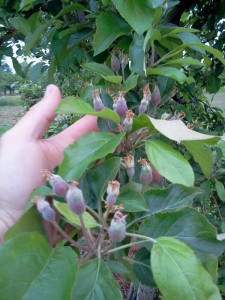The bloom is almost over. We have a few late apples (Rome Beauty) planted in the low spots that are still blooming, but for the most part, bloom is over and the bees have done their work. We were worried about the number of native bees in the orchard this year, but once again, we see a pretty good “set.” Now we turn our attention to thinning.
Thinning is the process of selectively removing all but a few of the tiny fruits so that the remaining fruit will achieve good size and color. The earlier we complete the thinning process, the more time that the tree can focus its growth on the remaining fruit, resulting in higher quality.
For example, in the picture, taken today in our Gala block, you can see the results of that beautiful bloom. Each ‘spur’ on the tree usually results in 4-6 blooms. The center bloom is the “king” bloom and will have the largest fruit. With even a 50% pollination rate, there are so many apples on the tree that if left untreated, the fruit would be small, and likely not develop uniform color because it would be shaded by its neighbors touching it. In extreme cases, the growing process could even knock the apples off the tree as neighboring fruit jockeys for space.
In peaches, we start the thinning process even before the blossoms are pollinated. The process is called blossom thinning and has only recently become mainstream. Basically, the process involves knocking off about half of the blooms before they ever have a chance to develop. Growers have developed some creative ways to blossom thin: from cordless drill-mounted wirlygigs, to tractor mounted whips that knock off blossoms, to the more manual hand-work. No matter which method is used, the timing is critical as the blossoms only last a short while. If the job is not done well, hand thinning will be necessary later in the season, with decreased quality and increased cost. If thinning is not done at all, the grower is almost guaranteed an unsaleable crop.
In apples, the thinning process is more automated, but nearly an art form. Almost all apples are thinned using sprays that are applied at exactly the right time at exactly the right quantity. The calculus used in the decision process includes a lot of notes as to how those trees have reacted in the past to thinning, and also includes careful consideration of not only the current weather, but the weather forecasted over the next several days. It turns out that more apples will drop if the weather will be cloudy and warm, and fewer will drop if the weather will be sunny and cool. Scientists at Cornell have developed a model to codify these observations, but there is still a lot of room for error.
All these variables make apple thinning a pretty stressful time around the orchard. This week’s forecast seems to have a lot of uncertainty with a forecasted easterly flow off the ocean that could lead to nearly constant cloudy weather with showers, or perhaps partly sunny skies with warm temperatures. The difference could be significant for thinning. Only time will tell.



Pingback: Timing is everything in this job | The Fruitful Tree